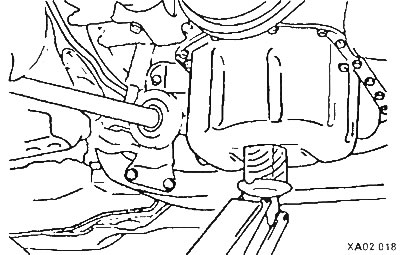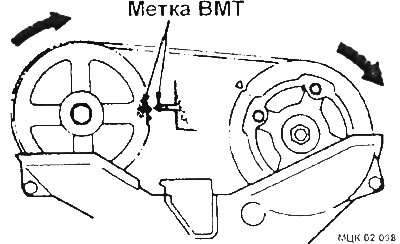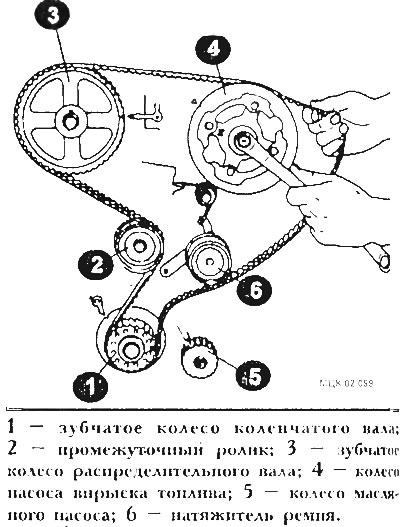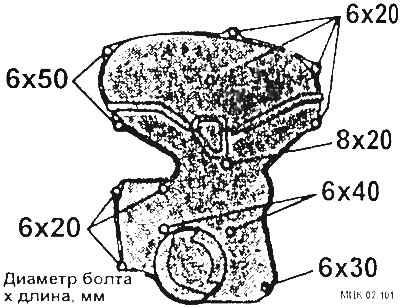
Adjusting elements of a gear belt
1 - engine mount bracket; 2 - V-belt of the power steering; 3 - V-belt of the air conditioning compressor; 4 - V-belt generator; 5 - crankshaft pulley; 6 - adapter; 7 - vibration damper; 8 - water pump pulley; 9 - tension roller bracket; 10 - the upper casing of the toothed belt; 11 - lower casing of the toothed belt; 12 - ventilation hose; 13 - cylinder head cover; 14 - cylinder head cover seal (semicircular); 13 - toothed belt; 16 - toothed belt tensioner; 17 - remote bushing; 18 - spring; 19 - guide roller.
Removing
Remove the cover and then remove the air filter.
Disconnect the top of the intake manifold from the bottom and from the holders. First, disconnect the duct for the outlet outlet, and remove the vent and air inlet hoses.
Unscrew the glow plugs.
Place a wooden jack under the oil sump and support the engine to remove the engine mount holder.

Remove the V-belt.
Loosen all rocker arm adjusting bolts until the ends of the bolts protrude only 0±2 mm.
Remove the top casing of a gear belt.
Rotate the crankshaft clockwise until the camshaft wheel mark is at TDC.
You can turn the crankshaft in several ways:
Raise the car from the front side. Engage 5th gear, apply the handbrake. Turn the raised front wheel, the crankshaft will rotate.
Turn the crankshaft at the center pulley bolt, but first engage neutral and apply the handbrake.
Rotate the engine until the mark on the camshaft wheel lines up with the pointer. Now the piston of the first cylinder is at TDC.

Unscrew the crankshaft gear.
Remove the bottom casing of a gear belt.
Mark the direction of the toothed belt with chalk. The toothed belt rotates clockwise.
Loosen the toothed belt tension and remove it.
Examination
The toothed belt must be replaced if the following faults are present:
- Traces of oil or coolant on the toothed belt. The reason for this is a leak in the seals of the housing or camshaft, or a leak in the water pump.
- Rubber seal on the outside of the toothed belt. The belt becomes shiny, hard.
- Rubber rips on the outside of the belt.
- Deformation of the fabric on the inside of the belt.
- Gusts at the base of the teeth and rips on the narrow side of the belt.
- Severe wear on the narrow side of the belt and teeth. Fraying of the fabric on the loaded side of the teeth Peeling off of the rubber and changing its color to white. Reducing the width of the teeth.
- Chipped teeth.
Installation
Check and, if necessary, set the TDC position of the camshaft, fuel injection pump, oil pump and crankshaft.
Put on the toothed belt, taking into account the marking of the direction of rotation. The old toothed belt must only be installed in the same direction of rotation.
Slide the timing belt over the crankshaft sprocket, then pass it through the idler pulley, through the camshaft sprocket, and through the oil pump sprocket. In this case, the toothed belt must fit between two adjacent wheels in a tensioned state. When the toothed belt is put on, align the TDC marking on the fuel injection pump wheel with the engine mark.

Put the toothed belt on the tension roller and tension the toothed belt.
Turn the toothed belt clockwise until all the TDC marks, which should match, match.

Check toothed belt tension.
Adjust valve clearances.
Install the cylinder head cover, installing the gaskets first.
Install the upper and lower toothed belt guards. Insert bolts depending on their diameters and lengths.

Install the V-belt.
Install the upper engine mount.
Install glow plugs.
Install the intake manifold top. To do this, insert new O-rings into the lower part of the manifold, put on the upper part and alternately tighten the bolts to 15 Nm. Fasten the collector to the holders with a force of 15 Nm. Fit the exhaust pipe with a new seal and tighten it with Nm. Connect the air intake ventilation hoses by securing them with clamps.
Install the air filter and then install the lower left cover.
